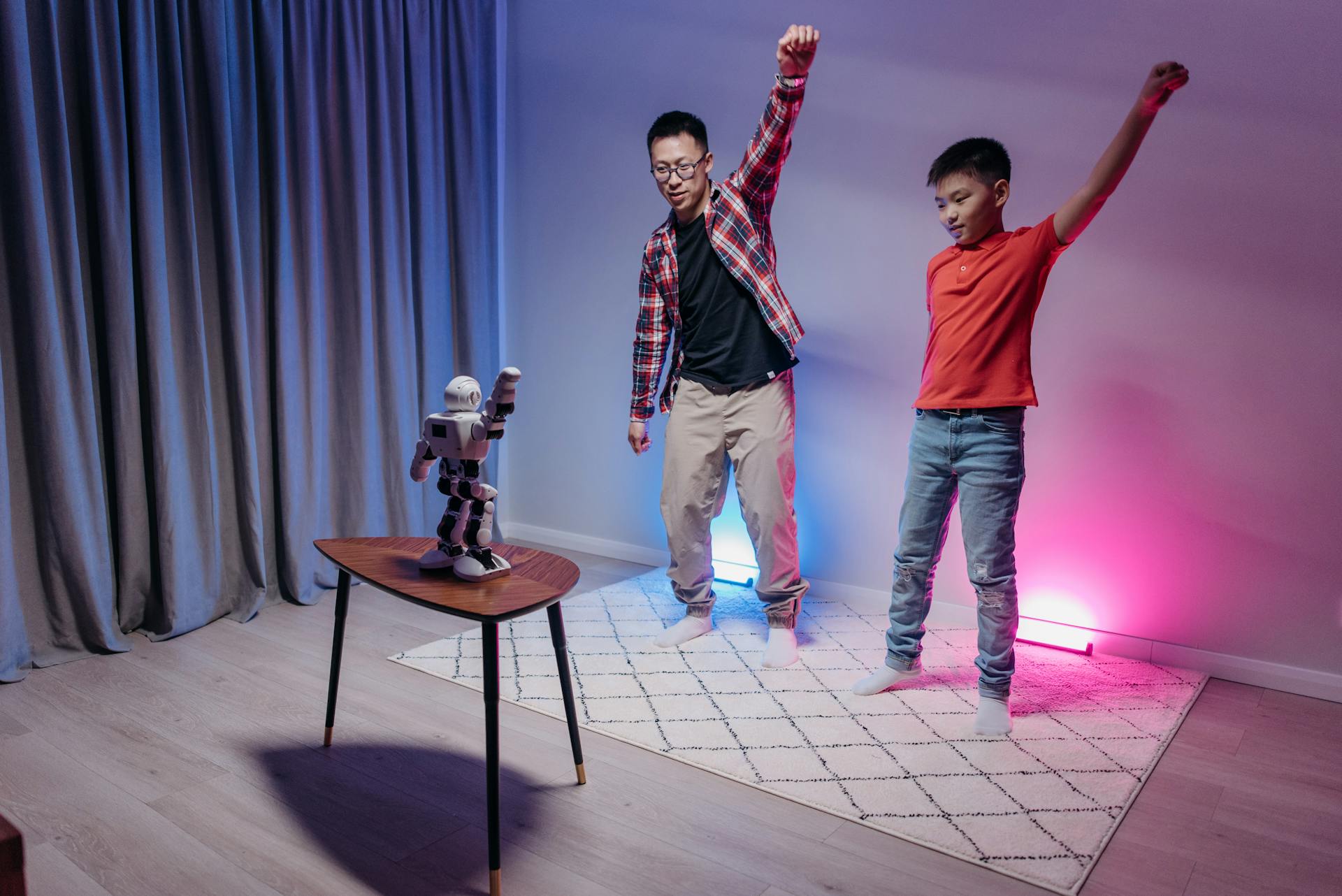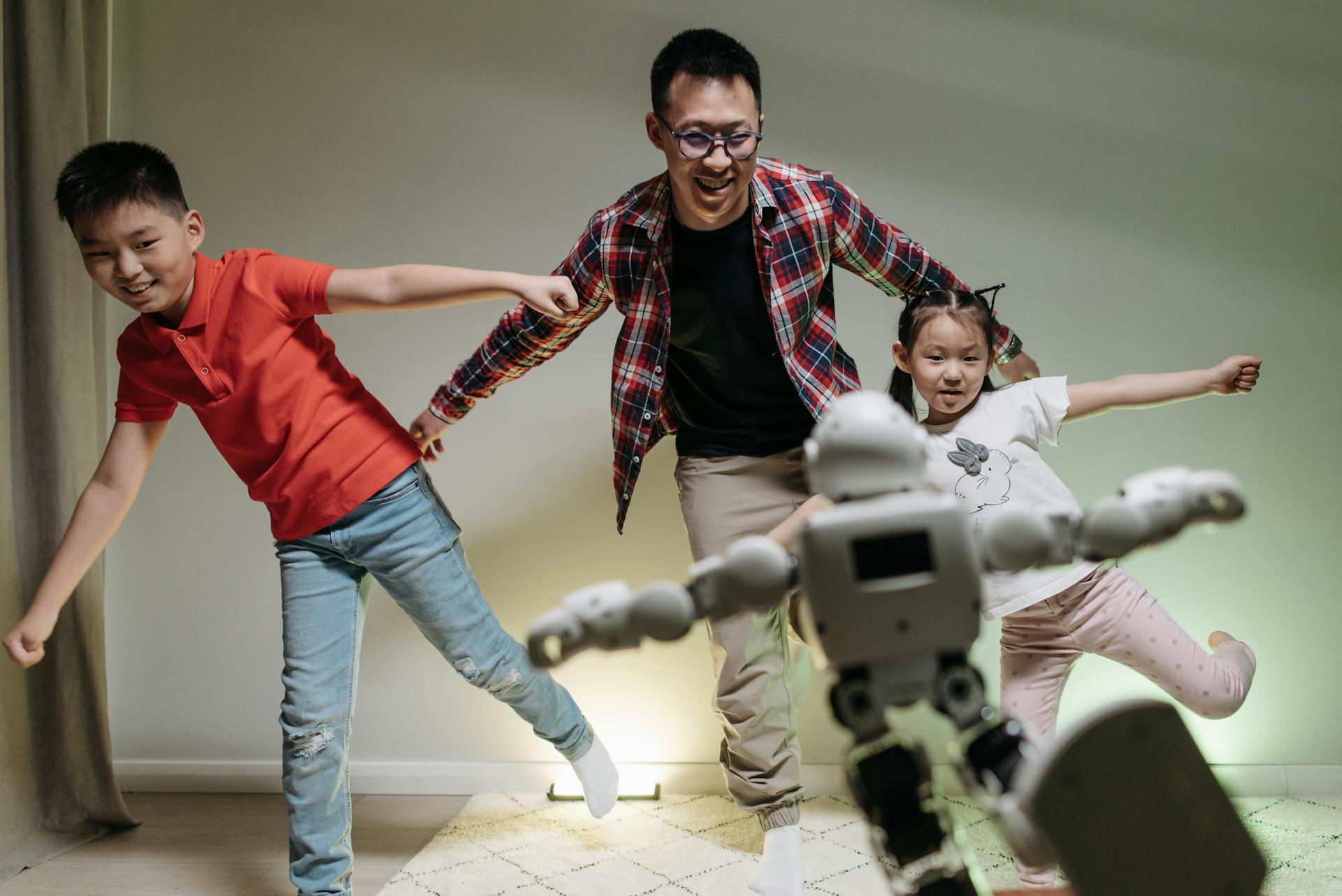
Cognitive robotics is a field that's all about creating robots that can think and learn like humans. It's a fusion of artificial intelligence, robotics, and cognitive science.
These robots can perceive their environment, make decisions, and adapt to new situations. They're like the ultimate problem-solvers.
Cognitive robots are designed to mimic the human brain's ability to process information and make decisions. They use sensors and algorithms to gather data and learn from it.
Imagine having a robot that can help you with household chores, like cleaning and cooking, and also learn from your preferences and habits. That's what cognitive robotics aims to achieve.
Readers also liked: Cognitive Ai vs Generative Ai
What is Cognitive Robotics?
Cognitive robotics is a branch of robotics that focuses on giving robots intelligent behavior through learning and experience. It's a field that's still evolving, and its nature can be quite amorphous.
Cognitive robotics generally involves designing and using robots with human-like intelligence in perception, motor control, and high-level cognition. To achieve this, many overlapping disciplines are needed, such as robotics, artificial intelligence, cognitive science, neuroscience, biology, philosophy, psychology, and cybernetics.
Curious to learn more? Check out: Artificial Intelligence Glossary
The field of cognitive robotics is all about creating robots that can learn from their experiences and adapt to new situations. According to Clark and Grush, a key component of cognition is fluent, coupled real-world action-taking.
Here are some important considerations for cognitive robotics:
- We hold that fluent, coupled real-world action-taking is a necessary component of cognition.
- Cognition, we want to say, requires both fluent real-world coupling and the capacity to improve such engagements by the use of learning and experience.
Approaches and Techniques
Cognitive robotics is a diverse field with several subfields contributing to its nature. These subfields include approaches that enable robots to behave intelligently in complex environments.
Cognitive robotics techniques integrate computational neuroscience to enhance robotic cognitive abilities. This integration is key to enabling robots to adapt to dynamic situations.
Several subfields within cognitive robotics contribute to its diverse nature. One of these subfields is cognitive robotics techniques, which involve various methods for intelligent behavior in robots.
The field of cognitive robotics involves various techniques that enable robots to behave intelligently in dynamic and complex environments. These techniques are essential for robots to navigate and interact with their surroundings effectively.
Check this out: Applied Machine Learning Explainability Techniques
Development and Evolution
Developmental robotics draws inspiration from child development, aiming to create robots that acquire skills through interactions with their environment, much like human infants. This approach integrates developmental psychology, neuroscience, and robotics, focusing on the autonomous acquisition of complex sensorimotor and cognitive abilities.
Developmental robots learn and adapt in real-time, developing new skills and knowledge through exploration and social interaction. This methodology not only advances robot autonomy but also offers insights into human cognitive development.
Evolutionary robotics uses principles of natural selection and genetic algorithms to evolve robot behaviors and physical forms. Robots in this field are treated as autonomous organisms that undergo simulated evolution, developing new capabilities over generations.
You might enjoy: Formal Operational Stage of Development
Developmental
Developmental approaches aim to create robots that acquire skills through interactions with their environment, much like human infants. This is evident in developmental robotics, which draws inspiration from child development.
Developmental robots learn and adapt in real-time, developing new skills and knowledge through exploration and social interaction.
See what others are reading: Artificially Intelligent Robots
Evolutionary
Evolutionary robotics uses principles of natural selection and genetic algorithms to evolve robot behaviors and physical forms.
This approach aims to create adaptive and robust robots capable of evolving to meet new challenges and environments.
Robots in this field are treated as autonomous organisms that undergo simulated evolution, developing new capabilities over generations.
By evolving neural network controllers and physical structures, evolutionary robotics creates innovative and efficient solutions to complex tasks, mirroring nature’s adaptive processes.
Key Concepts and Principles
Cognitive robotics is a field that combines artificial intelligence (AI) with robotics to enable machines to exhibit human-like cognitive capabilities. It's a robotics field focused on equipping robots with intelligent behavior through AI, enabling them to learn and operate autonomously.
The key features of cognitive robotics include adaptability, autonomy, learning ability, and decision-making. These features allow robots to perform complex tasks, adapt to new situations, and interact effectively with their environment.
Cognitive robots are equipped with advanced sensors and algorithms that allow them to perceive their environment in a manner similar to human perception. This includes visual, auditory, and tactile sensors that help the robot understand and interpret its surroundings.
Curious to learn more? Check out: Human in the Loop Approach
Machine learning plays a crucial role in cognitive robotics, enabling robots to learn from their experiences and improve their performance over time. This capability enables them to adapt to new tasks and environments without explicit programming.
Cognitive robots can make decisions based on the information they gather and the goals they need to achieve. This involves complex reasoning processes, such as planning, problem-solving, and understanding cause-and-effect relationships.
Here are some key concepts in cognitive robotics:
- Perception: Cognitive robots use advanced sensors and algorithms to perceive their environment.
- Learning: Machine learning enables robots to learn from their experiences and improve their performance over time.
- Reasoning and Decision-Making: Cognitive robots can make decisions based on the information they gather and the goals they need to achieve.
- Human-Robot Interaction: Cognitive robots are designed to interact with humans in a natural and intuitive manner.
Symbolic reasoning and neural computing are integral to cognitive robotics. Symbolic reasoning allows robots to process high-level abstract information and execute human-like logic, while neural computing uses methods like neural networks to process continuous data and sensory inputs.
Computational neuroscience studies how the brain computes information, providing insights that are crucial in developing cognitive robotic systems. This interdisciplinary field involves creating models that mimic neural processing to endow robots with intelligent capabilities.
A different take: Hidden Layers in Neural Networks Code Examples Tensorflow
Some key components of computational neuroscience include neural networks, Hebbian learning, and spiking neurons. Neural networks are computational models inspired by the human brain's architecture, allowing robots to process information and learn from data. Hebbian learning is a principle emphasizing synaptic adaptation, akin to neural plasticity, frequently applied in robotics for memory and learning functions. Spiking neurons simulate neuronal spikes to interpret temporal patterns and encode sensory stimuli efficiently.
Curious to learn more? Check out: Computational Learning Theory
Examples
Cognitive robots are being used in various industries to perform complex tasks without explicit human intervention. They can adapt to new situations and learn from their experiences.
In healthcare, cognitive robots are being used for tasks such as patient monitoring, surgery assistance, and rehabilitation. They can interact with patients and provide personalized care.
Cognitive robots in manufacturing improve efficiency and precision by adapting to changes in the production line and identifying defects.
They can also be found in the service industry, where they're used for customer interaction, information dissemination, and even companionship. Cognitive robots can understand and respond to customer queries, providing a more personalized experience.
Some examples of cognitive robotics applications include:
- Healthcare: patient monitoring, surgery assistance, and rehabilitation
- Manufacturing: production line adaptation, defect identification, and process optimization
- Service Industry: customer interaction, information dissemination, and companionship
- Research and Development: exploring new frontiers in robotics, AI, and human cognition
Resources and Studies
If you're interested in cognitive robotics, there are several advanced studies you can pursue. A master's or Ph.D. in cognitive robotics or a related field will allow you to specialize and contribute to cutting-edge research.
Cognitive robotics is a rapidly growing field with immense potential for the future. By understanding its core concepts, applications, and educational pathways, students can position themselves at the forefront of this technological revolution.
To get started, consider reading some foundational books on the subject. For example, Bekey's "Autonomous Robots" and Brooks' "Cambrian Intelligence" are excellent resources that will give you a solid understanding of the field.
Here are some key books and reviews to get you started:
- Bekey G (2005) Autonomous Robots: From Biological Inspiration to Implementation and Control. MIT Press, MA
- Brooks RA (1999) Cambrian Intelligence: The Early History of the New AI. MIT Press, MA
- Dennett DC (1991) Consciousness Explained. Little, MA
- Gabriel M, Moore J (eds) (1990) Learning and Computational Neuroscience: Foundations of Adaptive Networks. MIT Press, MA
- Haikonen PO (2003) The Cognitive Approach to Conscious Machines. Imprint Academic, UK
- Hauser MD (2000) Wild Minds. Henry Holt and Company, NY
- Meystel AM, Albus JS (2002) Intelligent Systems: Architecture, Design, and Control. Wiley, NY
- Nolfi S, Floreano D (2004) Evolutionary Robotics: The Biology, Intelligence, and Technology of Self‐organizing Machines. Bradford Book, MIT Press, MA
- Picard RW (1997) Affective Computing. MIT Press, MA
- Siegwart R, Nourbakhsh IR (2004) Introduction to Autonomous Mobile Robots. Bradford Book, MIT Press, MA
These books will provide you with a solid foundation in cognitive robotics and its applications.
Learning and Education
To get started in cognitive robotics, it's essential to have a strong foundation in computer science, artificial intelligence, and robotics.
Begin by taking courses in machine learning, cognitive science, and neuroscience to gain a deeper understanding of how robots think and learn.
A solid educational path will set you up for success in this exciting field, so don't be afraid to dive in and start learning.
Explore further: Masters in Computer Science Machine Learning
Educational Path
To get started on the educational path for cognitive robotics, it's essential to have a strong foundation in computer science, artificial intelligence, and robotics. This will provide a solid base for understanding the principles of cognitive robotics.
Machine learning is a crucial aspect of cognitive robotics, and courses in this subject will help you understand how robots can learn and adapt. You can learn about supervised learning, unsupervised learning, and reinforcement learning, which are all essential for cognitive robotics.
A degree in cognitive science or neuroscience can also be beneficial, as it will give you a deeper understanding of how humans and animals learn and process information. This knowledge can be applied to the development of more advanced cognitive robots.
Here are some key courses to consider:
- Machine learning
- Cognitive science
- Neuroscience
By taking these courses, you'll be well on your way to building a strong educational foundation in cognitive robotics.
Learn with Vaia App Flashcards
Learning with Vaia App Flashcards is a game-changer for anyone looking to improve their knowledge retention and recall. The app allows users to create digital flashcards, which can be accessed anywhere, at any time.
Vaia App Flashcards can be customized with images, audio, and text, making learning more engaging and interactive. This feature helps to capture users' attention and retain information better.
One of the most significant advantages of Vaia App Flashcards is its ability to track user progress and identify areas where improvement is needed. This feature helps users to focus on the most challenging topics and optimize their study time.
By using Vaia App Flashcards, users can learn at their own pace and review material as often as needed, without feeling overwhelmed. This flexibility is essential for effective learning and retention.
Sources
- https://www.datasciencecentral.com/cognitive-robotics-part-one/
- https://www.vaia.com/en-us/explanations/engineering/artificial-intelligence-engineering/cognitive-robotics/
- https://sd2.org/introduction-to-cognitive-robotics/
- https://link.springer.com/10.1007/978-0-387-30440-3_74
- http://ifrr.org/cognitive-robotics
Featured Images: pexels.com


